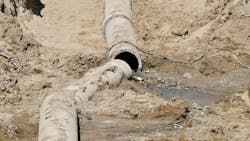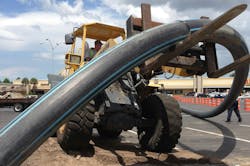New Document Provides Seismic Design Criteria for HDPE Water Mains
IRVING, TX — A new report that examines the required wall thickness for a fully fused high-density polyethylene (HDPE) water main to withstand the lateral spread from an earthquake or other seismic event has been published. Researched and authored by Michael O’Rourke, Ph.D., P.E., F.SEI, M.ASCE Professor Emeritus Civil Engineering at the Rensselaer Polytechnic Institute, the Design of HDPE Water Mains for the Lateral Spread Seismic Hazard is now available at the websites of the PPI Municipal Advisory Board, the 2023 Plastic Pipes Conference (PPCA), and the 2024 NASTT No-Dig Conference.
“This critically important document provides the criteria for the proper design of an HDPE water main system,” stated Camille George Rubeiz, P.E., F. ASCE, co-chair, HDPE Municipal Advisory Board, and senior director of engineering for the PPI Municipal & Industrial Division. “According to the latest United States Geological Survey, nearly 75 percent of the United States could experience an earthquake during the next 100 years that would cause significant damage, including underground water mains. Professor O’Rourke’s analysis of possible seismic events, lateral spreads and wave propagation hazards with formulas and charts provide the much needed data to help system designers."
The two primary seismic hazards to buried pipelines are wave propagation and permanent ground deformation. Because earthquakes are caused by movement at a fault, the resulting movement results in waves traveling away from the fault. These waves stretch and bend pipeline infrastructure at or near the ground surface and is referred to as the wave propagation (WP) hazard.
“The WP hazard occurs in all earthquakes and is most commonly quantified by the resulting ground strain,” O’Rourke explained. “The WP hazard is also transitory in that after the shaking ends, the ground returns to its original pre-quake position. If the earthquake is large, it can also result in permanent offsets at the surface or movements of the ground (lateral spread hazard) both referred to as permanent ground deformation (PGD). The report addresses the lateral spread hazard and the strains due to PGD which are larger and hence more important than those due to WP.”
O’Rourke’s document contains formulas, calculations, empirical data, and illustrations plus nomenclature and definitions, all of which can be used in designing the HDPE water piping system.
“Being intrinsically able to withstand seismic shifts along with corrosion resistance, leak-proof fused joints creating a monolithic HDPE piping system, having a high degree of flexibility, and high ductility, are among the many reasons HDPE pipe is recognized to be the best product used for seismic installations and, of course, trenchless installations,” Rubeiz stated.
The paper and additional information can be found at www.plasticpipe.org/mabpubs

